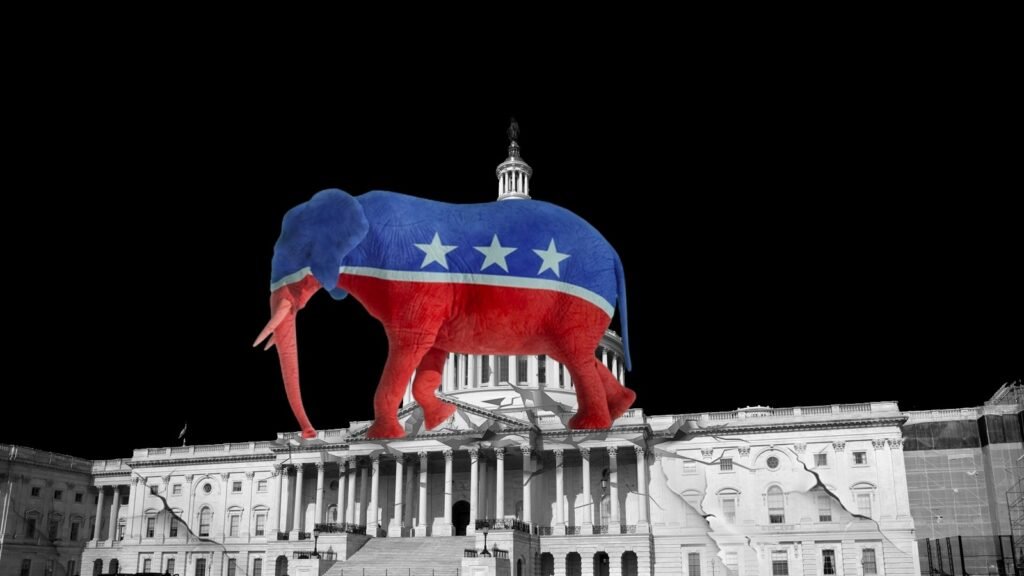In an overwhelming Republican sweep, the GOP seized control of the U.S. Senate and strengthened its position in the House of Representatives, shifting the political landscape and placing former President Donald Trump back in the White House. This sweeping victory reflects a significant redirection in American politics, driven by complex voter concerns that ultimately sidelined the Democratic Party. While Republicans celebrated this “red tsunami,” Democrats face the question: why did they lose the polls so decisively?
The GOP’s success stems from a mix of strategic campaigning, widespread dissatisfaction with the Democratic approach to pressing issues, and backlash against what some voters saw as an excessive focus on divisive social issues. With early wins in key Senate races in West Virginia and Ohio, the Republicans secured a majority, positioning themselves to reshape the legislative agenda in favor of Trump’s conservative policies. For many voters, a government led by Trump and supported by a Republican Congress was a prospect that promised a break from the perceived inaction and overreach of the previous administration.
One factor that likely contributed to the Republican sweep was the Democratic Party’s focus on gender and social issues, which often appeared out of step with the immediate concerns of average voters. Many Americans, grappling with economic strain, immigration challenges, and a general sense of instability, felt that the Democrats prioritized issues that didn’t resonate with their everyday realities. Rather than focusing on jobs, inflation, and community safety, Democratic campaigns frequently emphasized gender politics, inclusivity initiatives, and identity-based platforms, which some experts suggest alienated moderate voters. According to political analyst Tom Bales, “The Democrats misread their base, leaning too heavily on progressive issues while neglecting the bread-and-butter topics that most Americans vote on.” This imbalance, many argue, allowed Republicans to capture the attention of the undecided and disgruntled middle ground.
Democrats’ reliance on criticism of Trump also backfired, transforming what might have been a straightforward rejection of Trumpism into a groundswell of sympathy for the former president. The near-constant portrayal of Trump as a villain, especially through relentless ad campaigns, inadvertently bolstered his image among some voters, who began to view the attacks as politically motivated rather than factual. This phenomenon wasn’t lost on Republican strategist Kelly Jameson, who noted, “Every time Democrats tried to paint Trump as unfit, they reminded his supporters and undecided voters of why they initially liked his blunt style and ‘outsider’ stance.” For many Americans, these attacks appeared less as critiques of Trump’s policies and more as a personal crusade, which ultimately polarized rather than persuaded voters.
Additionally, many swing voters were looking for stability amid economic challenges and rising inflation, concerns that had become especially relevant in recent years. While Democrats invested heavily in House races, they focused less on economic solutions and more on defensive narratives. The Democratic Party’s spending in competitive races was unprecedented, yet their message failed to connect on a fundamental level. Polls indicate that for most voters, economic stability and employment security outweighed ideological concerns—a miscalculation that the Republicans exploited by framing themselves as the “common-sense” alternative. GOP campaigns leaned into issues that directly impacted voters’ wallets, from economic policies to tax cuts, making a persuasive case for a Republican-led government capable of addressing these challenges. In short, the Democrats’ campaign resources failed to yield the intended returns, even with significant financial investments in advertising and media.
Republicans, meanwhile, capitalized on their message of “America First” policies. Trump’s platform emphasized strict immigration enforcement, job creation, and tax reform, attracting voters seeking straightforward answers to complex problems. The GOP also mobilized its base effectively in key battleground districts, and the media coverage of Trump’s dramatic campaign drew massive public attention, effectively sidestepping the Democrats’ attempts to undermine his candidacy. As Republican House Speaker Mike Johnson put it, “The voters made it clear that they want strong, decisive leadership in the House and Senate.” This broad appeal, combined with targeted efforts to connect with working-class and rural voters, formed the backbone of the GOP’s success.
Moreover, this election cycle revealed a distinct voter fatigue with the Democrat-driven campaigns against “Trumpism.” As Democratic strategist Laura Simmons reflected, “What the Democrats underestimated was the extent to which voters had grown desensitized to Trump’s rhetoric.” After years of warnings about the dangers of a Trump presidency, many voters felt these narratives were exaggerated or simply repetitive. As a result, they either disengaged or turned toward the Republicans, who presented a more unified vision. Additionally, Trump’s re-election provided a semblance of continuity and nostalgia for his prior presidency, which some voters remembered as a period of robust economic growth. By painting Trump as an underdog, the Democrats inadvertently created a wave of empathy that resonated with his base and beyond.
Republicans are now poised to make their mark on everything from judicial appointments to fiscal policies, with Trump leading the charge and backed by a Congress eager to enact conservative reforms. This potential consolidation of GOP power could lead to sweeping changes in legislation and executive action, shaping the future of American politics. The Democrats face a critical juncture as they assess the missed signals and strategize on how to address the widening gap with the electorate’s priorities.
As the dust settles on this historic Republican takeover, it remains clear that the GOP’s success was not simply a result of Trump’s influence, but a culmination of effective messaging, strategic alignment with voter concerns, and, perhaps most crucially, the Democrats’ missteps. The Republicans now have a unique opportunity to reshape policy with a supportive Congress. For the Democrats, this election serves as a stark reminder of the importance of listening to voters, addressing real-world issues, and avoiding over-reliance on divisive narratives.


